Paris, the capital of art.
Among the world-famous museums in Paris, the Musée d'Orsay boasts one of the most beautiful collections that even connoisseurs can appreciate.
It is characterized by its collection of works from the Impressionist and Post-Impressionist periods, which are known as "modern art.
Visitors can see works by great painters such as the famous Monet and Van Gogh.
In this issue, we will introduce the charm of the Musée d'Orsay, as well as specific directions on how to access the museum!
What is the Musée d'Orsay?
A museum reusing a train station
Upon entering the Musée d'Orsay, the first thing that strikes you is the majestic European atmosphere of the building.
That is because the Musée d'Orsay is a museum that opened in 1986, reusing the Orsay Station, which was originally built for the 1900 Paris Exposition.
The long space and round ceiling characteristic of the station building allow soft natural light to fall on the sculptures, making it one of the most beautiful museums in the world.
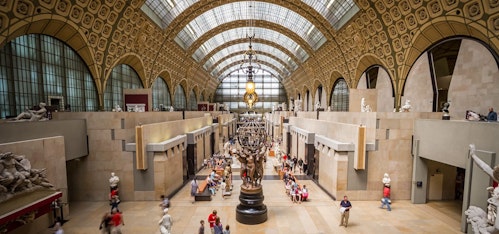
Differences from the Louvre
Paris is also home to the world's largest art museum, the Louvre.
It is also famous for owning the world's most famous painting, "Mona Lisa," but what is the difference between the Louvre and Orsay?
The answer is the difference in the age of the works in the collection.
The Louvre is a museum whose collection mainly consists of works dating back to 1848, while the Musée d'Orsay exhibits works from 1848 to 1914, the beginning of World War I. The Louvre is a museum whose collection is mainly made up of works dating back to the French Revolution and the end of World War I, while the Orsay is a museum whose collection is made up of works dating from the end of World War I. This was a period of turmoil following the French Revolution, the end of the monarchy, and the arrival of the age of the people in France. Paris was the center of world culture and art during this period, and the Museum d'Orsay exhibits many of the works that became the basis of Impressionism, Post-Impressionism, and modern art, and that have greatly influenced contemporary art.
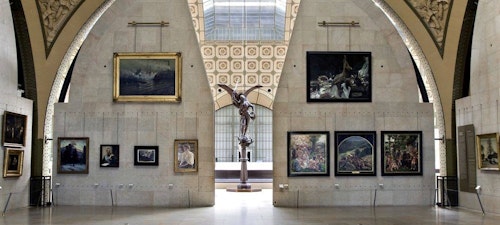
Works to see at the Musée d'Orsay
Here are 10 works from the Orsay Collection that you must see if you visit the museum.
(1) "The Fallen Earl" by Jean-François Millet
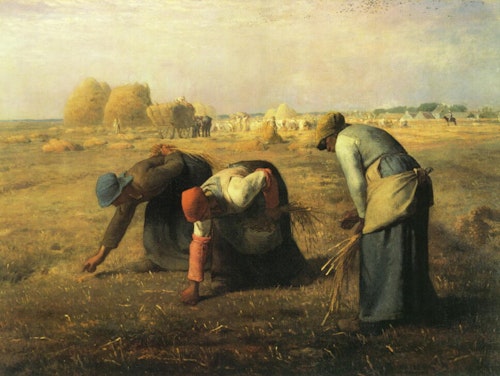
Jean-François Millet, 1857
The painting "Picking Up the Harvest" depicts three farm women picking up the fallen ears after the harvest; behind them, many people are engaged in harvest work, and the harvested wheat is piled high.
Far from the bustle of the harvest, three farmwives silently pick up the fallen ears of grain.
The perspective of the farm women and the farmer in the background is expressed through the use of aerial perspective, and the work evokes a sense of the dignity of human beings who are struggling to survive amidst the nature of the sky and the earth.
(2) "Self-Portrait" (Van Gogh)

Vincent van Gogh, 1889
Van Gogh left a significant mark on the history of art. He is also famous for having painted a number of self-portraits.
In fact, it is said that the reason why he painted so many self-portraits was because he could not hire models for financial reasons.
In his self-portraits, Van Gogh used them as an opportunity to experiment with the techniques of painting that he had encountered and adopted, such as impressionism and ukiyo-e techniques.
(3) "Starry Moonlit Night on the Rhone River
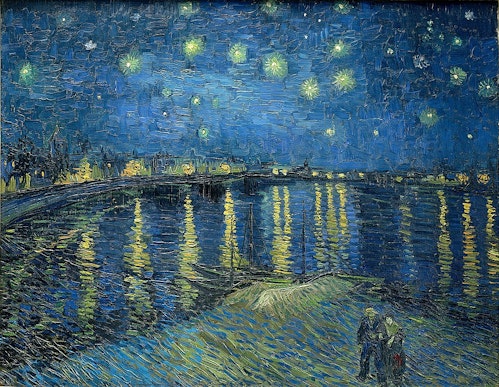
Vincent van Gogh, 1888
Another famous night landscape by Van Gogh is entitled "Starry Moonlit Night. Van Gogh's studio in Arles, known as "The Yellow House," is where he and Gauguin later lived together for three months, and where they experienced their breakup.
Van Gogh, also known as the "Painter of Color," is known for his ingenious use of nocturnal scenes.
He tries to capture both the stars in the night sky, which have been shining since time immemorial, and the artificial light of gas lamps, which were born and became popular during this period.
4) "Apples and Oranges
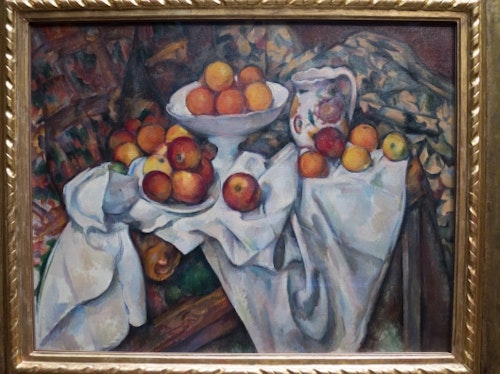
Paul Cezanne, 1899
I want to surprise Paris with apples," was Cézanne's favorite saying.
A white cloth is carelessly thrown over a small wooden table placed at an angle, and several pieces of fruit appear to be randomly lying on the table.
At first glance, the painting looks quite ordinary, but upon closer inspection, the jug is tilted, the plate is also tilted and the fruit is about to roll off, and the corners of the table, hidden by the white cloth, are not connected.
Cézanne's unique style, which is related to Cubism that depicted a single object from various angles, was supported by his policy of "composing and depicting the scene seen from the angle at which the object looks most beautiful.
(5) "Woman of Tahiti (on the beach)
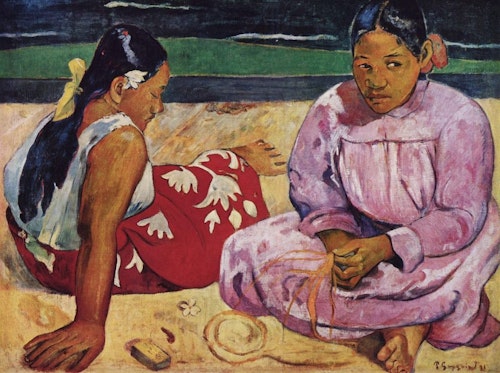
Paul Gauguin ,1891
Gauguin originally worked as a stockbroker in Paris, and his oil paintings, which he began as a hobby, later became his professional livelihood. He was initially associated with Pissarro and other leading Impressionists, but gradually tired of the hectic Parisian atmosphere, he moved to the then French island nation of Tahiti, located in Oceania.
This work is from 1891, the year he went to Tahiti in search of freedom and pristine beauty.
The woman on the left has her eyes closed as if contemplating something, and the other woman has an enigmatic expression on her face as she holds a leaf. This mysterious atmosphere is exactly what Gauguin was looking for in the untamed land of Tahiti.
(6) "Olympia
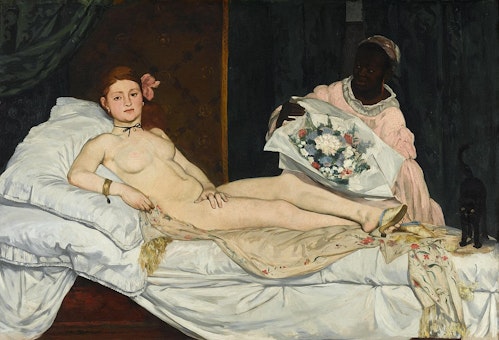
Edouard Manet, 1863
First of all, it is noteworthy that the female model in "Olympia," which caused a scandal when it was exhibited at the 1863 Salon (government exhibition), is nude. At the time, it was common practice in the art world to depict women in the nude, but the model in "Olympia" is nude, yet gazes at the viewer with an egocentric gaze. This is an innovative expression in which the woman is depicted not as a submissive subject, but as a self-assertive subject.
Also noteworthy is the depiction of the model's body. In conventional art, the female body tends to pursue an idealized beauty, but the model in "Olympia" has a realistic physical expression. This gives the viewer a realistic impression of the work's period.
Another appealing aspect of this work is the meticulous depiction of the curtains in the background and the black cat by the model's side. Manet's creative expressiveness is demonstrated in these details, enhancing the completeness of the work as a whole.
(7) "The Ball at Moulin de la Galette
.jpg?w=500&h=371)
Pierre-Auguste Renoir, 1863
The lively atmosphere felt throughout the painting is one of its charms. In this depiction of a ball, numerous figures are dancing, drinking, and eating. Each person is enjoying himself or herself in his or her own way, giving the viewer the feeling of being among them. In addition, the upper right corner of the painting depicts a view of the ballroom from a vantage point, giving the viewer a sense of spatial expansion.
The facial expressions and poses of the figures in the painting are also fascinating. Renoir expresses the personalities and emotions of the people in his paintings through detailed depictions. For example, the couple in the center of the painting, a man and a woman, are depicted as intimate lovers, and we can infer their emotions from their facial expressions and hand movements.
8) "Blue Water Lilies
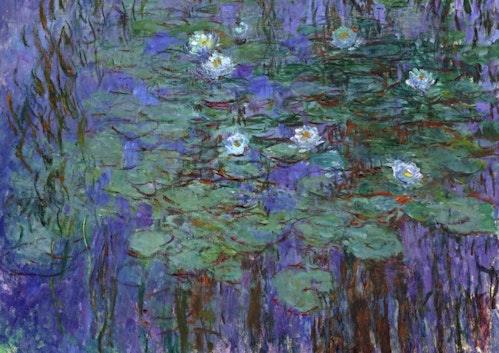
Claude Monet, 1916
The charm of this work lies in the depiction of the light reflecting off the surface of the pond with blue water lilies and the surface of the water. Monet was extremely sensitive to subtle changes in light and the expression of light and shadow, and the light on the surface of the water and the blue coloring are in beautiful harmony. The pond with blue-toned water lilies represents a quiet and peaceful space, providing a soothing effect to the viewer. Monet also placed the painting at an angle to make the blue water lilies appear larger and more three-dimensional.
Another appeal of this work is Monet's technical dexterity. Monet used a multitude of colors to express light, and even within the blues and purples there is a wide variety of tones. He also has a very free touch with his brush, and depicts natural objects such as grass, flowers, and leaves with a unique sensibility.
(ix) "Painter's Studio
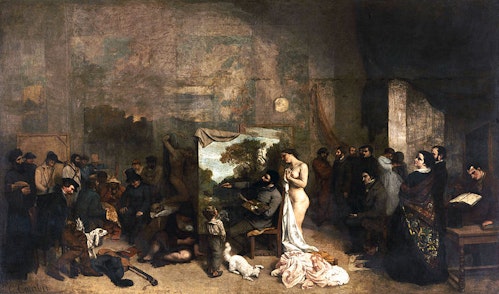
Gustave Courbet, 1849
This work is also known as one of the representative works of Courbet's pursuit of "realism," which he himself advocated. Realism aims to realistically depict the reality of society in art, and Courbet was one of the artists who most adhered to this idea. The artist's studio is a work that embodies the philosophy of realism, and one of the charms of this work is that it depicts aspects of the society and culture of the time in the landscape that the artist himself depicts.
Courbet also painted another shocking work, "The Origin of the World," which depicts only female genitalia, and which is also in the collection of the Orsay.
(10) "Gray and Black Arrangement No. 1: Portrait of the Mother

James McNeill Whistler, 1871
The most appealing aspect of this work is that the portrait of the mother is presented in an artistic arrangement that differs from a realistic portrait. Specifically, the mother's clothing, pose, and background are depicted in an abstract, aesthetic style, giving the impression at first glance that the painting is not a portrait. In addition, the use of gradations of pale gray and black in the colors gives the impression of simplicity and beauty.
Furthermore, the work contains questions about the relationship between art and reality. Heussler questioned the complete reproduction of reality in his paintings and insisted on expressing elements extracted from reality in an artistic manner. This work also embodies this idea, and although it is a portrait of his mother, it has been artistically arranged to pursue its aesthetic value as a painting.
Such an idea is reflected in the title, which in this work is also called "Arrangement.
Directions and Admission to the Musée d'Orsay
Access
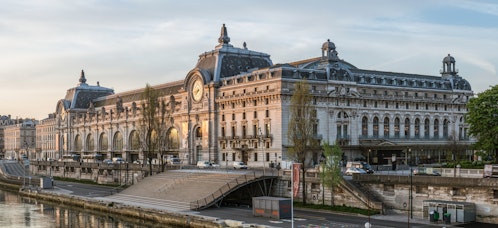
The Musée d'Orsay is located along the Seine River in the heart of Paris. It is also close to the Louvre Museum, less than a 15-minute walk across the Seine.
The closest station by public transportation is the Gare Musée d'Orsay (RER) station on line C of the RER (Paris Suburban Railway ).
From the Solférino station, it is less than a 5-minute walk.
Hours of Operation and Holidays
Opening hours: 9:30-18:00 (until 21:45 on Thursdays)
Last admission 17:00 (until 21:00 on Thursdays)
Closed: Mondays, May 1 and December 25
Approximate tour time
It will take about 2 hours if you visit at a very brisk pace, or about 3 hours if you visit at a normal pace.
If you plan to view the sculptures and other exhibits carefully, it may take 4 to 5 hours. Be sure to allow enough time for your visit.
Admission
There are four entrances, A through C.
To purchase tickets on the day of the event, enter from A. If you have purchased tickets in advance from the official website, enter from Entrance C.
After all, there is often a long line at Entrance A, so it is recommended to purchase tickets in advance.
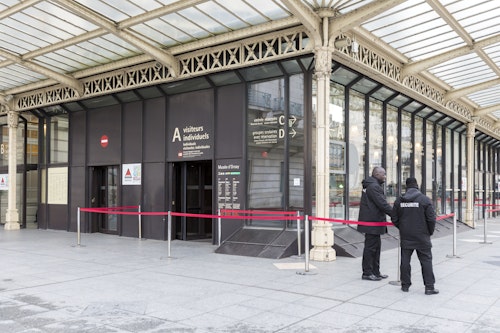
(Reference) Musee d'Orsay official website
Musee d'Orsay official website
TRiCERA ART members enjoy a variety of privileges and preferences.
- Discounts such as members-only secret sales and coupons
- Create your own collection by registering your favorite artists
- Receive updates on popular artists, exhibitions, and events
- Receive a weekly newsletter with selected art
- Personal Assessment to find out what kind of art you like.
Please register as a member for free and receive the latest information.
Free Member Registration